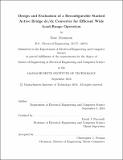| dc.contributor.advisor | David J. Perreault. | en_US |
| dc.contributor.author | Abramson, Rose (Rose A.) | en_US |
| dc.contributor.other | Massachusetts Institute of Technology. Department of Electrical Engineering and Computer Science. | en_US |
| dc.date.accessioned | 2017-12-20T17:23:53Z | |
| dc.date.available | 2017-12-20T17:23:53Z | |
| dc.date.copyright | 2016 | en_US |
| dc.date.issued | 2016 | en_US |
| dc.identifier.uri | http://hdl.handle.net/1721.1/112817 | |
| dc.description | Thesis: M. Eng., Massachusetts Institute of Technology, Department of Electrical Engineering and Computer Science, 2016. | en_US |
| dc.description | This electronic version was submitted by the student author. The certified thesis is available in the Institute Archives and Special Collections. | en_US |
| dc.description | Cataloged from student-submitted PDF version of thesis. | en_US |
| dc.description | Includes bibliographical references (pages 277-279). | en_US |
| dc.description.abstract | This thesis presents the design and implementation of a step-down soft-switched dc-dc converter based on an active bridge topology which overcomes some of the limitations of the conventional dual-active bridge (DAB). The topology comprises a double-stacked bridge inverter, coupled to a recongurable rectifier through a special three-winding leakage transformer. The converter can run in a low power mode that greatly increases light-load efficiency by reducing core loss and extending the zero-voltage switching (ZVS) range. The converter is implemented with a single compact magnetic component, providing power combining, isolation, and energy transfer inductance. The theory of the converter and its various operating modes, referred to in this thesis as the Double-Stacked Active Bridge converter, is also explored, and a magnetic model of the special three-winding transformer and leakage inductance is presented. The target application is for 380 V dc distribution systems for data centers, where the converter operates for the majority of the time at the nominal input voltage, but must have high eciency over a wide load range. A 175 kHz, 300 W, 380 V to 12 V prototype converter achieves 95.9% efficiency at full load, a peak efficiency of 97.0%, an efficiency above 92.7% down to 10% load and an efficiency above 79.8% down to 3.3% load. | en_US |
| dc.description.statementofresponsibility | by Rose Abramson. | en_US |
| dc.format.extent | 279 pages | en_US |
| dc.language.iso | eng | en_US |
| dc.publisher | Massachusetts Institute of Technology | en_US |
| dc.rights | MIT theses are protected by copyright. They may be viewed, downloaded, or printed from this source but further reproduction or distribution in any format is prohibited without written permission. | en_US |
| dc.rights.uri | http://dspace.mit.edu/handle/1721.1/7582 | en_US |
| dc.subject | Electrical Engineering and Computer Science. | en_US |
| dc.title | Design and evaluation of a reconfigurable stacked active Bridge dc/dc converter for efficient wide load-range operation | en_US |
| dc.type | Thesis | en_US |
| dc.description.degree | M. Eng. | en_US |
| dc.contributor.department | Massachusetts Institute of Technology. Department of Electrical Engineering and Computer Science | |
| dc.identifier.oclc | 1014132883 | en_US |

